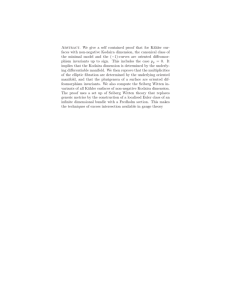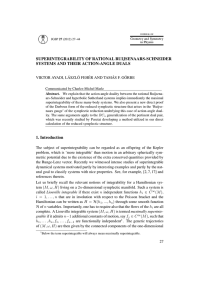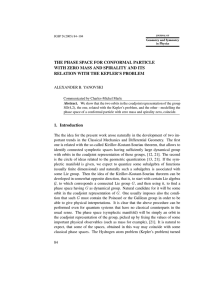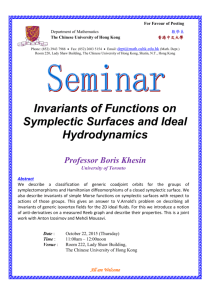Diffeomorphisms, symplectic forms and Kodaira fibrations
advertisement
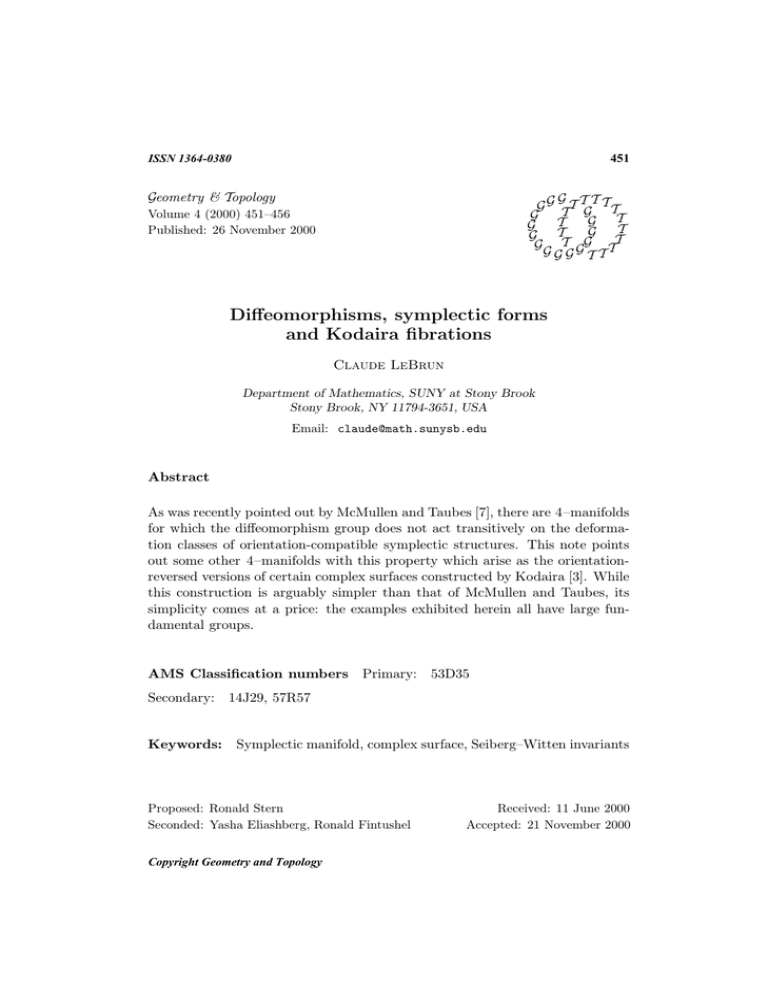
451
ISSN 1364-0380
Geometry & Topology
G
T
G G TT TG T T
G
G T
T
G
G T GG TT
G T G
GG G T TT
Volume 4 (2000) 451–456
Published: 26 November 2000
Diffeomorphisms, symplectic forms
and Kodaira fibrations
Claude LeBrun
Department of Mathematics, SUNY at Stony Brook
Stony Brook, NY 11794-3651, USA
Email: claude@math.sunysb.edu
Abstract
As was recently pointed out by McMullen and Taubes [7], there are 4–manifolds
for which the diffeomorphism group does not act transitively on the deformation classes of orientation-compatible symplectic structures. This note points
out some other 4–manifolds with this property which arise as the orientationreversed versions of certain complex surfaces constructed by Kodaira [3]. While
this construction is arguably simpler than that of McMullen and Taubes, its
simplicity comes at a price: the examples exhibited herein all have large fundamental groups.
AMS Classification numbers
Primary: 53D35
Secondary: 14J29, 57R57
Keywords:
Symplectic manifold, complex surface, Seiberg–Witten invariants
Proposed: Ronald Stern
Seconded: Yasha Eliashberg, Ronald Fintushel
Copyright Geometry and Topology
Received: 11 June 2000
Accepted: 21 November 2000
452
Claude LeBrun
Let M be a smooth, compact oriented 4–manifold. If M admits an orientationcompatible symplectic form, meaning a closed 2–form ω such that ω ∧ ω is an
orientation-compatible volume form, one might well ask whether the space of
such forms is connected. In fact, it is not difficult to construct examples where
the answer is negative. A more subtle question, however, is whether the group
of orientation-preserving diffeomorphisms M → M acts transitively on the set
of connected components of the orientation-compatible symplectic structures
of M . As was recently pointed out by McMullen and Taubes [7], there are
4–manifolds M for which this subtler question also has a negative answer. The
purpose of the present note is to point out that many examples of this interesting
phenomenon arise from certain complex surfaces with Kodaira fibrations.
A Kodaira fibration is by definition a holomorphic submersion f : M → B from
a compact complex surface to a compact complex curve, with base B and fiber
Fz = f −1 (z) both of genus ≥ 2. (In C ∞ terms, f is thus a locally trivial
fiber bundle, but nearby fibers of f may well be non-isomorphic as complex
curves.) One says that M is a Kodaira-fibered surface if it admits such a
⊗`
fibration f . Now any Kodaira-fibered surface M is algebraic, since KM ⊗f ∗ KB
is obviously positive for sufficiently large `. On the other hand, recall that a
holomorphic map from a curve of lower genus to a curve of higher genus must
be constant.1 If f : M → B is a Kodaira fibration, it follows that M cannot
contain any rational or elliptic curves, since composing f with the inclusion
would result in a constant map, and the curve would therefore be contained in
a fiber of f ; contradiction. The Kodaira–Enriques classification [2] therefore
tells us that M is a minimal surface of general type. In particular, the only
non-trivial Seiberg–Witten invariants of the underlying oriented 4–manifold M
are [8] those associated with the canonical and anti-canonical classes of M .
Any orientation-preserving self-diffeomorphism of M must therefore preserve
{±c1 (M )}.
We have just seen that M is of Kähler type, so let ψ denote some Kähler form on
M , and observe that ψ is then of course a symplectic form compatible with the
usual ‘complex’ orientation of M . Let ϕ be any area form on B , compatible
with its complex orientation, and, for sufficiently small ε > 0, consider the
closed 2–form
ω = εψ − f ∗ ϕ.
Indeed, by Poincaré duality, a continuous map h: X → Y of non-zero degree
between compact oriented manifolds of the same dimension must induce inclusions
h∗ : H j (Y, R) ,→ H j (X, R) for all j . Such a map h therefore cannot exist whenever
bj (X) < bj (Y ) for some j .
1
Geometry and Topology, Volume 4 (2000)
Diffeomorphisms, symplectic forms and Kodaira fibrations
453
Then
ω∧ω
= −2(f ∗ ϕ) ∧ ψ + εψ ∧ ψ = (ε − hf ∗ ϕ, ψi) ψ ∧ ψ,
ε
where the inner product is taken with respect to the Kähler metric corresponding to ψ . Now hf ∗ ϕ, ψi is a positive function, and, because M is compact,
therefore has a positive minimum. Thus, for a sufficiently small ε > 0, ω ∧ ω
is a volume form compatible with the non-standard orientation of M ; or, in
other words, ω is a symplectic form for the reverse-oriented 4–manifold M .
For related constructions of symplectic structures on fiber-bundles, cf [6].
If follows that M carries a unique deformation class of almost-complex structures compatible with ω . One such almost-complex structure can be constructed by considering the (non-holomorphic) orthogonal decomposition
T M = ker(f∗ ) ⊕ f ∗ (T B)
induced by the given Kähler metric, and then reversing the sign of the complex structure on the ‘horizontal’ bundle f ∗ (T B). The first Chern class of the
resulting almost-complex structure is thus given by
c1 (M , ω) = c1 (M ) − 4(1 − g)F,
where g is the genus of B , and where F now denotes the Poincaré dual of a
fiber of f . For further discussion, cf [4, 5, 9].
Of course, the product B × F of two complex curves of genus ≥ 2 is certainly
Kodaira fibered, but such a product also admits orientation-reversing diffeomorphisms, and so, in particular, has signature τ = 0. However, as was first
observed by Kodaira [3], one can construct examples with τ > 0 by taking
branched covers of products; cf [1, 2].
Example Let C be a compact complex curve of genus k ≥ 2, and let B1 be
a curve of genus g1 = 2k − 1, obtained as an unbranched double cover of C .
Let ι: B1 → B1 be the associated non-trivial deck transformation, which is a
free holomorphic involution of B1 . Let p: B2 → B1 be the unique unbranched
cover of order 24k−2 with p∗ [π1 (B2 )] = ker[π1 (B1 ) → H1 (B1 , Z2 )]; thus B2 is a
complex curve of genus g2 = 24k−1 (k − 1) + 1. Let Σ ⊂ B2 × B1 be the union of
the graphs of p and ι ◦ p. Then the homology class of Σ is divisible by 2. We
may therefore construct a ramified double cover M → B2 × B1 branched over
Σ. The projection f1 : M → B1 is then a Kodaira fibration, with fiber F1 of
genus 24k−2 (4k−3)+1. The projection f2 : M → B2 is also a Kodaira fibration,
with fiber F2 of genus 4k − 2. The signature of this doubly Kodaira-fibered
complex surface is τ (M ) = 24k (k − 1).
Geometry and Topology, Volume 4 (2000)
454
Claude LeBrun
We now axiomatize those properties of these examples which we will need.
Definition Let M be a complex surface equipped with two Kodaira fibrations
fj : M → Bj , j = 1, 2. Let gj denote the genus of Bj , and suppose that the
induced map
f 1 × f 2 : M → B 1 × B2
has degree r > 0. We will then say that (f1 , f2 ) is a Kodaira double-fibration
of M if τ (M ) 6= 0 and
(g2 − 1) 6 | r(g1 − 1).
In this case, (M, f1 , f2 ) will be called a Kodaira doubly-fibered surface.
Of course, the last hypothesis depends on the ordering of (f1 , f2 ), and is automatically satisfied, for fixed r, if g2 g1 . The latter may always be arranged
by simply replacing M and B2 with suitable covering spaces.
Note that r = 2 in the explicit examples given above.
Given a Kodaira doubly-fibered surface (M, f1 , f2 ), let M denote M equipped
with the non-standard orientation, and observe that we now have two different
symplectic structures on M given by
ω1 = εψ − f1∗ ϕ1
ω2 = εψ − f2∗ ϕ2
for any given area forms ϕj on Bj and any sufficiently small ε > 0.
Theorem 1 Let (M, f1 , f2 ) be any Kodaira doubly-fibered complex surface.
Then for any self-diffeomorphism Φ: M → M , the symplectic structures ω1
and ±Φ∗ ω2 are deformation inequivalent.
That is, ω1 , −ω1 ,Φ∗ ω2 , and −Φ∗ ω2 are always in different path components
of the closed, non-degenerate 2–forms on M . (The fact that ω1 and −ω1 are
deformation inequivalent is due to a general result of Taubes [10], and holds for
any symplectic 4–manifold with b+ > 1 and c1 6= 0.)
Theorem 1 is actually a corollary of the following result:
Theorem 2 Let (M, f1 , f2 ) be any Kodaira doubly-fibered complex surface.
Then for any self-diffeomorphism Φ: M → M ,
Φ∗ [c1 (M , ω2 )] 6= ±c1 (M , ω1 ).
Geometry and Topology, Volume 4 (2000)
Diffeomorphisms, symplectic forms and Kodaira fibrations
455
Proof Because τ (M ) 6= 0, any self-diffeomorphism of M preserves orientation. Now M is a minimal complex surface of general type, and hence, for the
standard ‘complex’ orientation of M , the only Seiberg–Witten basic classes [8]
are ±c1 (M ). Thus any self-diffeomorphism Φ of M satisfies
Φ∗ [c1 (M )] = ±c1 (M ).
Letting Fj be the Poincaré dual of the fiber of fj , and letting gj denote the
genus of Bj , we have
c1 (M , ωj ) = c1 (M ) + 4(gj − 1)Fj
for j = 1, 2. The adjunction formula therefore tells us that
[c1 (M , ωj )] · [c1 (M )] = (2χ + 3τ )(M ) − 2χ(M ) = 3τ (M ) 6= 0,
where the intersection form is computed with respect to the ‘complex’ orientation of M .
If we had a diffeomorphism Φ: M → M with Φ∗ [c1 (M , ω2 )] = ±c1 (M , ω1 ), this
computation would tell us that that
Φ∗ [c1 (M )] = c1 (M ) =⇒ Φ∗ [c1 (M , ω2 )] = c1 (M , ω1 )
and that
Φ∗ [c1 (M )] = −c1 (M ) =⇒ Φ∗ [c1 (M , ω2 )] = −c1 (M , ω1 ).
In either case, we would then have
4(g1 −1)F1 = c1 (M , ω1 )−c1 (M ) = ±Φ∗ [c1 (M , ω2 )−c1 (M )] = ±4(g2 −1)Φ∗ (F2 ).
On the other hand, F1 · F2 = r, so intersecting the previous formula with F2
yields
4(g1 − 1)r = 4(g1 − 1)F1 · F2 = 4(g2 − 1)[±Φ∗ (F2 ) · F2 ],
and hence
(g2 − 1) | r(g1 − 1),
in contradiction to our hypotheses. The assumption that Φ∗ [c1 (M , ω1 )] =
±c1 (M , ω2 ) is therefore false, and the claim follows.
Theorem 1 is now an immediate consequence, since the first Chern class of a
symplectic structure is deformation-invariant.
Acknowledgment This work was supported in part by NSF grant DMS0072591.
Geometry and Topology, Volume 4 (2000)
456
Claude LeBrun
References
[1] M F Atiyah, The signature of fibre-bundles, from “Global Analysis (Papers in
honor of K Kodaira)”, Univ. Tokyo Press, Tokyo (1969) 73–84
[2] W Barth C Peters, A V de Ven, Compact complex surfaces, Springer–Verlag
(1984)
[3] K Kodaira, A certain type of irregular algebraic surfaces, J. Analyse Math. 19
(1967) 207–215
[4] D Kotschick, Signatures, monopoles and mapping class groups, Math. Res.
Lett. 5 (1998) 227–234
[5] N C Leung, Seiberg–Witten invariants and uniformizations, Math. Ann. 306
(1996) 31–46
[6] D McDuff, D Salamon, Introduction to symplectic topology, Oxford Science
Publications, The Clarendon Press and Oxford University Press, New York
(1995)
[7] C T McMullen, C H Taubes, 4–manifolds with inequivalent symplectic forms
and 3–manifolds with inequivalent fibrations, Math. Res. Lett. 6 (1999) 681–696
[8] J Morgan, The Seiberg–Witten equations and applications to the topology of
smooth four–manifolds, vol. 44 of Mathematical Notes, Princeton University
Press (1996)
[9] J Petean, Indefinite Kähler–Einstein metrics on compact complex surfaces,
Comm. Math. Phys. 189 (1997) 227–235
[10] C H Taubes, More constraints on symplectic forms from Seiberg–Witten invariants, Math. Res. Lett. 2 (1995) 9–14
Geometry and Topology, Volume 4 (2000)
